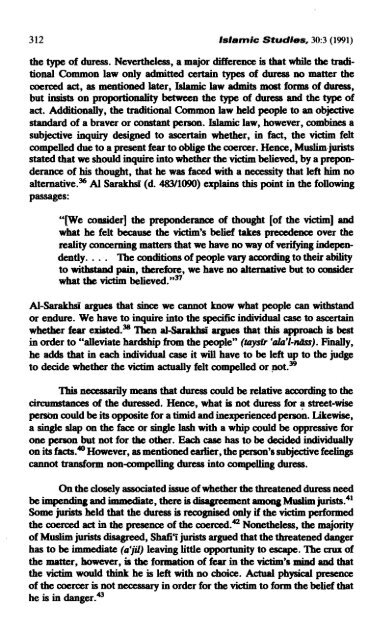LAW OF DURESS IN ISLAMIC LAW AND COMMON LAW: A ...
LAW OF DURESS IN ISLAMIC LAW AND COMMON LAW: A ...
LAW OF DURESS IN ISLAMIC LAW AND COMMON LAW: A ...
Create successful ePaper yourself
Turn your PDF publications into a flip-book with our unique Google optimized e-Paper software.
312 Islamic Studies, 30:3 (1991)<br />
the type of duress. Nevertheless, a major difference is that while the traditional<br />
Common law only admitted certain types of duress no matter the<br />
coerced act, as mentioned later, Islamic law admits most forms of duress,<br />
but insists on proportionality between the type of duress and the type of<br />
act. Additionally, the traditional Common law held people to an objective<br />
standard of a braver or constant person. Islamic law, however, combines a<br />
subjective inquiry designed to ascertain whether, in fact, the victim felt<br />
compelled due to a present fear to oblige the coercer. Hence, Muslimjurists<br />
stated that we should iuquire into whether the victim believed, by a preponderance<br />
of his thought, that he was faced with a necessity that left him no<br />
alte~native.~~ Al Sarakhsi (d. 483/1090) explains this point in the following<br />
passages:<br />
"[We consider] the preponderance of thought [of the victim] and<br />
what he felt because the victim's belief takes precedence over the<br />
reality concerning matters that we have no way of verifying indepen-<br />
dently. . . . The conditions of people vary according to their ability<br />
to withstand pain, therefore, we have no alternative but to wnsider<br />
what the victim believed.""<br />
Al-Sara argues that since we cannot know what people can withstand<br />
or endure. We have to inquire into the specific individual case to ascertain<br />
whether fear existed.38 Tben a14arakW argues that this approach is best<br />
in order to "alleviate hardship from the people" (taysfr 'ulu'l-?I&). Finally,<br />
he adds that in each individual case it will have to be left up to the judge<br />
to decide whether the victim actually felt compelled or not.39<br />
This necessarily means that duress could be relative according to the<br />
circumstances of the duressed. Hence, what is not duress for a street-wise<br />
persion could be its opposite for a timid and inexperienced persoh. Iikewise,<br />
a single slap on the face or single lash with a whip could be oppressive for<br />
one person but not for the other. Each case has to be decided individually<br />
on its facts.& However, as mentioned earlier, the person's subjective feelings<br />
cannot transform noncompelling duress into compelling duress.<br />
On the closely associated issue of whether the threatened duress need<br />
be impending and immediate, there is dhgreement among Muslim<br />
Some jurists held that the duress is recognised only if the victim performed<br />
the coerced act in the presence of the coerced." Nonetheless, the majority<br />
of Muslim jurists disagreed, Shafi'i jurists argued that the threatened danger<br />
has to be immediate (a'jif) leaving little opportunity to escape. The crux of<br />
the matter, however, is the formation of fear in the victim's mind and that<br />
the victim would think he is left with no choice. Actual physical presence<br />
of the coercer is not necessary in order for the victim to form the belief that<br />
he is in danger."
















